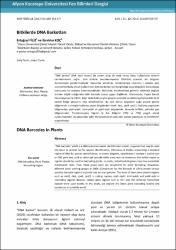| dc.contributor.author | Filiz, Ertuğrul | |
| dc.contributor.author | Koç, İbrahim | |
| dc.date | 2014-11-21 | |
| dc.date.accessioned | 2014-11-21T08:21:28Z | |
| dc.date.available | 2014-11-21T08:21:28Z | |
| dc.date.issued | 2012 | |
| dc.identifier.issn | 2147-5296 | |
| dc.identifier.uri | http://hdl.handle.net/11630/856 | |
| dc.description.abstract | “DNA barkot” DNA dizisi temelli bir sistem olup bir veya birkaç lokus kullanılarak türlerin
tanımlanmasını sağlar. Yani türlerin tanımlanmasında DNA’daki standart bir bölgenin
dizilenmesini gerektirmektedir. Hayvanlar aleminde, mitokondriyal sitokrom c oksidaz geni
evrensel barkodu olarak kullanılırken bitki barkotları için hangi bölge veya bölgelerin kullanılacağı
konusunda bir uzlaşma bulunmamaktadır. Bitkilerde, mitokondriyal genlerin nükleotid değişim
oranları düşük olduğundan bitki barkodu olarak uygun değillerdir. Günümüzde, Yaşam Barkot
Konsorsiyumu’na (CBOL) bağlı farklı bitki çalışma grupları çekirdek ve plastid genomundaki farklı
barkot bölge adaylarını test etmektedirler. Bu test edilen bölgelerin çoğu plastid genom
bölgeleridir ki örneğin kodlama yapan bölgelerden matK, rbcL, rpoB, rpoC1, kodlama yapmayan
bölgelerden atpF–atpH, trnH–psbA ve psbK–psbI bölgeleridir. Bununla birlikte, çekirdek gen
bölgelerinden Transkripsiyonu Yapılan İç Ara Bölgeler (ITS1 ve ITS2) yaygın olarak
kullanılmaktadır. Bu çalışmada, bilim dünyasındaki en yeni bitki barkot çalışmaları ve yönelimleri
araştırılmıştır. | en_US |
| dc.description.abstract | “DNA barcode” which is a DNA sequence-based identification system, supports that may be used
one locus or several loci for species identification. Otherwise, it implies sequencing a standard
region of DNA for species identification. In animal kingdom, cytochrome c oxidase 1 (called coxI
or COI) gene was used as universal barcode while there was no consensus that which region or
regions should be used for barcoding plants. In plants, mitochondrial genes have low nucleotide
substitution rates. Thus, these genes were not convenient for plant barcoding. Nowadays,
different plant working groups in CBOL (Consortium for the Barcode of Life’s) tested various
putative barcode regions in plastid and nuclear genome. The most of them were plastid regions
such as matK, rbcL, rpoB, rpoC1 in coding regions, atpF–atpH, trnH–psbA, and psbK–psbI in
noncoding regions. Besides, nuclear gene regions such as ITS1 and ITS2 (Internal Transcribed
Spacer) were used widely. In this study, we explore the latest plant barcoding studies and
tendencies in scientific world. | en_US |
| dc.language.iso | tur | en_US |
| dc.publisher | Afyon Kocatepe Üniversitesi | en_US |
| dc.rights | info:eu-repo/semantics/openAccess | en_US |
| dc.subject | DNA Barkot; Bitki; Plastid; Kodlama Yapmayan Bölge | en_US |
| dc.title | Bitkilerde DNA Barkotları | en_US |
| dc.title.alternative | DNA Barcodes in Plants | en_US |
| dc.type | article | en_US |
| dc.relation.journal | Fen Bilimleri Dergisi | en_US |
| dc.department | Düzce Üniversitesi Çilimli Meslek Yüksek Okulu, Bitkisel ve Hayvansal Üretim Bölümü, Çilimli, Düzce Moleküler Biyoloji ve Genetik Bölümü, Gebze Yüksek Teknoloji Enstitüsü | en_US |
| dc.authorid | TR48694 | en_US |
| dc.identifier.volume | 12 | en_US |
| dc.identifier.startpage | 53 | en_US |
| dc.identifier.endpage | 57 | en_US |
| dc.identifier.issue | 1 | en_US |
| dc.relation.publicationcategory | Makale - Ulusal Hakemli Dergi - Kurum Yayını | en_US |



















